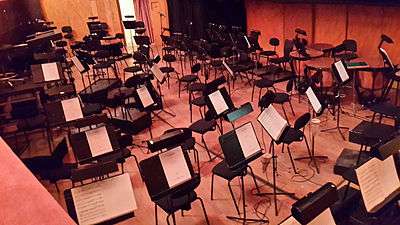Pit orchestra

A pit orchestra is a type of orchestra that accompanies performers in musicals, operas, ballets and other shows involving music. The terms was also used for orchestras accompanying silent movies when more than a piano was used.[1] In performances of operas and ballets, the pit orchestra is typically similar in size to a symphony orchestra, though it may contain smaller string and brass sections, depending upon the piece. Such orchestras may vary in size from approximately 30 musicians (early Baroque and Classical opera) to as many as 90–100 musicians (Wagnerian opera). However, because of financial, space, and volume concerns, the musical theatre pit orchestra in the 2000s is considerably smaller (at most 20–30 musicians, including not more than ten string players).
Description
Typically, pit orchestras play in a lowered area in front of the stage called an orchestra pit. Inside the pit, the conductor stands facing towards the stage with his or her back towards the audience to coordinate the music with the vocals and actions of the singers, dancers and actors, while the orchestra sits facing the conductor. The conductor may also sit at one or more keyboards and conduct as well as play, which often means the use of more head and facial gestures rather than hand gestures. This is often the case when a show only requires a small orchestra, or on national tours, where the instrumentation is often reduced from the original arrangement and one or two keyboard players substitute for several instruments. In some cases, theatres do not have a pit; in this case, the pit orchestra may play in a room near the stage, watching the conductor's gestures using a video monitor.
Music parts for pit orchestra woodwind players in musical theatre are normally divided into "reed books". Orchestration varies with each show based on the type of music that will be performed, such as jazz, classical, or blues. For example, a Reed 1 Book may contain music for piccolo, flute, Eb alto saxophone, Bb clarinet, and/or oboe. A musician handed a reed book would be expected to play each part. Because the musician plays so many different instruments, he or she is referred to as a "doubler" (even though the Reed Books may have up to eight instruments each).[2]
Musicians who play in pit orchestras are not only required to play multiple instruments at times, but they must also be familiar and able to play in multiple keys, styles, and tempos and make a switch instantaneously. The orchestration for a musical is written in a key best suited to range of the singer. Some keys are more difficult to play in than others because of the increased attention that greater amounts of sharps and flats require. Musicals also tend to have a number of styles which can range from a soulful ballad to a syncopated funk tune to a driving hard rock song. Many musicians have been trained to play in a certain style, such as classical music, but in order to play in pit orchestras, musicians must be able to play a range of different styles. Because musicals are live, many elements can change from show to show; pit orchestra musicians consequently should be able to play different tempos every night and even skip through their music to a new spot if an actor or singer makes an error.
Preparation
As with any orchestra or similar ensemble, a pit orchestra rehearses with the singers and dancers before the public performances commence. The rehearsals are led by the conductor/music director, who sets the tempos, starts the songs and musical interludes and indicates pauses and endings of sections.
Although members of a pit orchestra are not required to demonstrate great stage presence, and they may work out of sight from much of the audience, they can generally be seen from the balcony seats and are thus required to adhere to standard rules of dress and appearance (e.g., formal clothes) [3]
Preparation by musicians in a pit orchestra consists of much more than attending rehearsals. Before the first rehearsal, ensemble musicians individually practice their parts, particularly difficult sections and exposed passages (e.g., instrumental solos). Performers may also listen to a recording of the show to learn the tempos and playing styles.
Size
Pit orchestras can range from large orchestras to small rock combos. While a pit orchestra usually plays in the orchestra pit, there are times when they are on stage in the background (this is usually for rock musicals). In some cases, one or more members of the pit orchestra may have to appear in costume on stage with their instrument and play music as part of a scene. Below are pit orchestra examples from five major theatrical license companies: Music Theatre International, Tams-Witmark, Samuel French, Inc., Rodgers and Hammerstein Theatricals, and Theatrical Rights Worldwide (excluding any conductor scores unless needed). These show the varying sizes of pit orchestras. Note that string parts are often written with the intent of having two musicians play a specific part, especially in older musicals.
In the 2000s, due to budget constraints, some musicals have replaced instruments from musical arrangements with keyboards. For example, instead of hiring a small string section, a musical may hire a synthesizer player to perform the string parts. Some musicals have used prerecorded music for shows.
Note that this orchestration is slightly different from the orchestration of the original Broadway production, which also called for a third trombone, a fifth reed, a harp, and did not have a dedicated piano player.
|